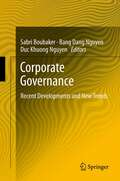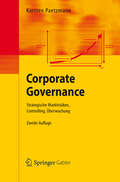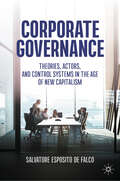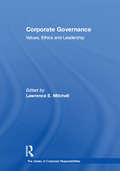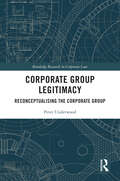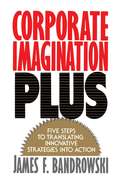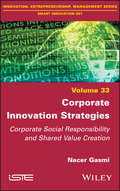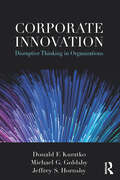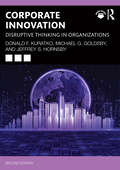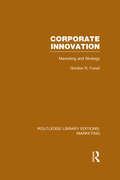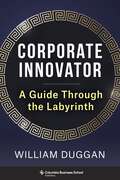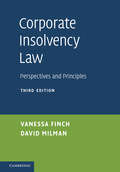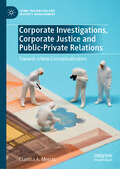- Table View
- List View
Corporate Governance: Promises Kept, Promises Broken
by Jonathan R. MaceyEven in the wake of the biggest financial crash of the postwar era, the United States continues to rely on Securities and Exchange Commission oversight and the Sarbanes-Oxley Act, which set tougher rules for boards, management, and public accounting firms to protect the interests of shareholders. Such reliance is badly misplaced. In Corporate Governance, Jonathan Macey argues that less government regulation--not more--is what's needed to ensure that managers of public companies keep their promises to investors. Macey tells how heightened government oversight has put a stranglehold on what is the best protection against malfeasance by self-serving management: the market itself. Corporate governance, he shows, is about keeping promises to shareholders; failure to do so results in diminished investor confidence, which leads to capital flight and other dire economic consequences. Macey explains the relationship between corporate governance and the various market and nonmarket institutions and mechanisms used to control public corporations; he discusses how nonmarket corporate governance devices such as boards and whistle-blowers are highly susceptible to being co-opted by management and are generally guided more by self-interest and personal greed than by investor interests. In contrast, market-driven mechanisms such as trading and takeovers represent more reliable solutions to the problem of corporate governance. Inefficient regulations are increasingly hampering these important and truly effective corporate controls. Macey examines a variety of possible means of corporate governance, including shareholder voting, hedge funds, and private equity funds. Corporate Governance reveals why the market is the best guardian of shareholder interests.
Corporate Governance: Recent Developments and New Trends (CSR, Sustainability, Ethics & Governance)
by Duc Khuong Nguyen Bang Dang Nguyen Sabri BoubakerThe current crisis has rocked the financial system worldwide and has cast doubt on the effectiveness of the existing regulatory regime. Thousands of firms have gone bankrupt and many financial institutions were bailed out by governments. The effects of the crisis have shaken emerging and developing markets alike and have not spared neither small nor large businesses. Many scholars and practitioners attribute the roots of the crisis to failures and weaknesses in the way corporate governance has been practiced since the mid-1990s. Lax board oversight of top management, short-termism and self-interested behavior have been fingered as the culprits behind recent financial turmoil. This book highlights the recent developments and new trends in corporate governance. The eighteen chapters, written by leading academics and experts, can assist corporate executives, governance bodies, investors, market regulators, and policymakers in having a global picture of major corporate governance issues. This book highlights the recent developments and new trends in corporate governance. The eighteen chapters, written by leading academics and experts, can assist corporate executives, governance bodies, investors, market regulators, and policymakers in having a global picture of major corporate governance issues.
Corporate Governance: Strategische Marktrisiken, Controlling, Überwachung
by Karsten PaetzmannSeit den 1990er Jahren werden weltweit Standards zur Verbesserung der Unternehmensführung diskutiert und in Empfehlungen oder Rechtsnormen gegossen. Ziel der Corporate Governance ist es, die Rationalität der Unternehmensführung zu erhöhen und insbesondere die Erkennung und Handhabung von Risiken zu verbessern. Anhand von Fallstudien zeigt der Autor, dass die Risiken des Marktumfeldes zwar eine herausragende Rolle spielen, dass die Unternehmensführung aber der Dualität des Marktumfeldes, also den Chancen und Risiken, Rechnung zu tragen hat.
Corporate Governance: Theories, Actors, and Control Systems in the Age of New Capitalism
by Salvatore Esposito De FalcoIn an era marked by financial scandals, corporate crises, and rapid technological advancements, this textbook equips readers with the knowledge and tools necessary to navigate the complexities of corporate governance effectively. Divided in three thematic sections, it offers a thorough examination of corporate governance theories, key actors and the systems of control essential in the current era of 'New Capitalism'. The chapters go beyond theoretical concepts, featuring numerous practical case studies drawn from real-world scenarios. Whether used as a textbook in academic settings, a reference guide in professional contexts, or a self-study resource, this textbook caters to diverse learning needs and preferences. Its organized structure and accessible language make it suitable for individuals at various stages of their academic or professional journey.
Corporate Governance: Values, Ethics and Leadership
by Lawrence E. MitchellThe study of corporate governance is a relatively modern development, with significant attention devoted to the subject only during the last fifty years. The topics covered in this volume include the purpose of the corporation, the board of directors, the role of shareholders, and more contemporary developments like hedge fund activism, the role of sovereign wealth funds, and the development of corporate governance law in what perhaps will become the dominant world economy over the next century, China. The editor has written an introductory essay which briefly describes the intellectual history of the field and analyses the material selected for the volume. The papers which have been selected present what the editor believes to be some of the best and most representative studies of the subjects covered. As a result the volume offers a rounded view of the contemporary state of the some of the dominant issues in corporate governance.
Corporate Governance: Values, Ethics and Leadership (Routledge Revivals)
by R. I. TrickerThis title was first published in 2000: The study of corporate governance is a relatively modern development, with significant attention devoted to the subject only during the last fifty years. The topics covered in this volume include the purpose of the corporation, the board of directors, the role of shareholders, and more contemporary developments like hedge fund activism, the role of sovereign wealth funds, and the development of corporate governance law in what perhaps will become the dominant world economy over the next century, China. The editor has written an introductory essay which briefly describes the intellectual history of the field and analyses the material selected for the volume. The papers which have been selected present what the editor believes to be some of the best and most representative studies of the subjects covered. As a result the volume offers a rounded view of the contemporary state of the some of the dominant issues in corporate governance.
Corporate Governing in Latin America: The Importance of Scandals to Institute Change
by Neil Pyper Jonathan Callund Gonzalo Jiménez-SeminarioGrounded in institutional theories, this volume offers a framework for understanding the evolution of corporate governance in the six leading Latin American countries, namely Argentina, Brazil, Chile, Colombia, Mexico, and Peru.Applying inductive qualitative methods, it postulates the notion of governing as a dynamic, emergent and contextual process and traces its evolution and adaption to the different configurations of institutional logics in each country and the region as a whole over several decades.Adopting corporate governance scandals as the lens through which to observe institutional change in each country, this book reveals the sources of societal transformations, identifying key lessons as well as meaningful setbacks along the way.This edited collection helps appreciate the role and interactions of corporate elites, stakeholders and watchdogs, including the visible hands of government and multinational corporations, presenting comparisons across the countries, the region and the broader evolution of governing practices around the globe.The result is a book combining scholarly rigor and practical relevance, looking to serve as an emerging markets benchmark guide for practitioners, researchers and thinktanks alike.
Corporate Group Legitimacy: Reconceptualising the Corporate Group (Routledge Research in Corporate Law)
by Peter UnderwoodThis book focuses on the legitimacy of corporate power wielded by corporate groups, integrating legal doctrine, economic analysis, and theoretical approaches. It reassesses how corporate groups can maintain legitimacy whilst exercising corporate power.Corporate groups are a prominent commercial feature of many jurisdictions and present unique challenges. The book argues that when analysed through the lens of corporate social responsibility, a legitimacy deficiency emerges. This arises from a lack of historical debate, diluted control mechanisms, and inflated growth, utilising unique features of the corporate group. It explores how the magnified power of the corporate group presents acute challenges for corporate legitimacy. Data is utilised alongside current examples of corporate groups which identify structural architectural patterns. It explores new technologies such as Artificial Intelligence and blockchain as ways of attaining legitimacy. It presents methods of attaining legitimacy for the continued wielding of power to be held within corporate groups.This book spans several research interests under the corporate law umbrella. It will be of interest to traditional black letter company lawyers. Additionally, it will be of interest to those who have an interest in business and those who are interested in the role of technology.
Corporate Groups and Shadow Business Practices
by Linn Anker-SørensenThe uniqueness of this book is its conceptualization of a corporate group as a system of interaction, comprised of nodes, links and internal governance tools. This framework can be used to understand what constitutes a group, based on affiliation-linkages. By increasing our perception of group-structuring we can assess the extent to which existing laws address all variables. If the law does not consider certain variables to be used for identifying groups, a case of shadow business may be identified. Group-transparency is a recurring topic on the regulatory agenda. In this book, three legal domains are analysed questioning whether specific amendments have led to increased group-transparency: the control-definition for consolidated accounts, shareholder-transparency in company law, and major holding disclosure in listed companies. This book identifies deficiencies of the law in obtaining its regulatory objective of group-transparency, and proposes an interpretative solution based on Systems Thinking.
Corporate Heritage Marketing: Using the Past as a Strategic Asset (Routledge Studies in Marketing)
by Angelo Riviezzo Antonella Garofano Maria Rosaria NapolitanoCorporate Heritage Marketing introduces the reader to the design and implementation of a heritage marketing strategy. It aims to propose a new and integrated reading of this marketing strategy, both from a theoretical and a managerial perspective. This book sets out to answer key questions, such as: how is it possible to engage all the company's stakeholders by exploiting corporate heritage? It also aims to discuss the basic principles for achieving a successful marriage between marketing and heritage. By highlighting the results of a research focused on 20 Italian companies, the book proposes a model for the development and implementation of a heritage marketing strategy. The nature of this book, being both theoretical and empirical, can contribute to increasing the curiosity and interest towards heritage marketing of both academics and practitioners.
Corporate Imagination Plus
by Jim BandrowskiUnlock the power of creativity and innovation in strategic planning with Jim Bandrowski's transformative five-step process designed to elevate your organization at every level—perfect for readers of You&’re the Boss and Grit.This groundbreaking book was the first to explain how to incorporate creativity and innovation into strategic planning—and motivate your organization to execute new strategies enthusiastically. Pioneering and practical, this book uses hundreds of real-world examples to explain Jim Bandrowski&’s five-step Creative Planning Process. These steps are proven to help a CEO create and implement a company-wide vision or assist division and department managers in setting strategic direction for their unit. Bandrowski shows readers how to innovate in every area of their organization—marketing, new product development, manufacturing, quality, human resources, finance, and customer service—at the corporate, division, department, and project levels. Interviews with corporate executives along with extensive research reveal the creative approaches their companies are using to win, including Apple Computer, Compaq Computer, Charles Schwab, Merck, Circus Circus, General Mills, McKesson Corporation, Gensler Associates, Dolby Laboratories, and many others. Thirty techniques for conceiving strategic breakthroughs are presented along with proven approaches to launching plans, monitoring their rollout, and assuring they are successfully put into action. Conventional strategic and operational planning do little to stimulate imagination. Bandrowski presents countless ways that executives and planning facilitators can blend rigorous strategic analysis with innovative thinking. Strategy development requires creativity. Learn how to: Develop strategic insights that lead to breakthroughs. Unleash your creativity through expansive thinking. Deploy your child, adult, and parent mindsets to innovate. Transform wild ideas into feasible options and then successful strategies. Become a shrewd strategic decision maker. Formulate crystal clear strategic and operational plans. Lead and facilitate teams in achieving strategic innovations. Brand your products and services to insure they drive growth. Reinvent operations to achieve quality breakthroughs and strategically reduce costs. The book&’s concluding section on Corporate Restructuring covers Creative Corporate Planning, Acquisition Bargains, Divesture Coups, and Corporate Turnaround Strategies. If you want to Out-Think and Out-Implement your competition, this book is for you.
Corporate Impact: Measuring and Managing Your Social Footprint
by Adrian HenriquesIt is widely accepted that sustainability has an inescapable social component, but companies find it very hard to understand and measure their social impacts. Why is this? This book, by noted CSR practitioner, consultant and educator Adrian Henriques, provides the first coherent approach to identifying, understanding, measuring and accounting for corporate social impact. Beginning with an analysis of the nature of corporate social impact and the role of the stakeholder, the complex relationship of social impact to economic and environmental impacts is explored. This naturally leads to an examination of the contribution which social impact makes to business practice, profitability and ultimately to global sustainability. The second part of the book assesses the theory and practise of some of the critical measures of social impact which have been developed to date. This includes Social Return on Investment (SROI), local economic impact (LM3) and social capital as well as more established techniques. . It also explores new approaches such as 'social footprinting'. This is rounded out by presentation of a social accounting framework and how this can operate in parallel to standard financial accounting procedures. This volume provides a clear, digestible and practical roadmap for companies wishing to take responsibility for their role in society and improve their internal and external performance.
Corporate Imperialism: Conflict and Expropriation
by Norman GirvanThis title was first published in 1976
Corporate Income Tax Harmonization in the European Union (Palgrave Macmillan Studies in Banking and Financial Institutions)
by Daniela PîrvuThrough the arguments for corporate tax harmonization in the EU and describing the current stage of this process, the legislative rules which are insufficient to solve the many problems implied by the proper functioning of the Single Market, are revealed. The book also exposes the issues involved in the consolidation of the corporate tax base.
Corporate Influencer: Mitarbeiter als Markenbotschafter (essentials)
by Martin SturmerMartin Sturmer zeigt in diesem essential, dass Mitarbeiter die besten Markenbotschafter sind – im Unterschied zu externen Influencern überzeugen Kommunikatoren aus dem eigenen Unternehmen (Corporate Influencer) durch Authentizität, Engagement und Fachwissen. Corporate Influencer haben ein enormes Potenzial: Sie stärken die Markenbekanntheit und steigern die Interaktionsraten mit Kunden und Interessenten. Außerdem verbessern sie die Mitarbeiterbindung und unterstützen den Aufbau einer starken Arbeitgebermarke. Der Autor vermittelt die wichtigsten Methoden und Instrumente für Unternehmen, die selbst ein erfolgreiches Corporate-Influencer-Programm ins Leben rufen wollen.
Corporate Innovation Strategies: Corporate Social Responsibility and Shared Value Creation
by Nacer GasmiCorporate social responsibility (CSR) is simply the maximization of a company's value over time, undertaken because, in the long run, social and environmental problems ultimately become financial problems. The justification for CSR is therefore associated with representing the nature and role of the company, as well as its purpose. Companies therefore regard CSR as a strategic investment that is part of a proactive, resilient, inclusive approach, based on the creation of shared value. This approach is capable of reducing negative societal impacts of their activities, or inducing positive impacts if they sustain a hybrid culture, all the while improving their competitive advantage. This book presents a theoretical development that analyzes the challenges of CSR strategies based on the creation of shared value. Two case studies are presented, analyzing the different forms of social innovation strategies capable of inducing this shared value creation.
Corporate Innovation: Disruptive Thinking in Organizations
by Donald F. Kuratko Jeffrey S. Hornsby Michael G. GoldsbyEffectiveness is the underlying theme for this introduction to disruptive innovation. The book tells the manager, or student, what they need to know in transforming the thinking in an organization to an innovative mindset in the twenty-first century.Corporate Innovation explains the four stages of the innovation process, and demonstrates how to improve skills in the innovation process, and unleash personal innovative abilities. This book also presents ways to assess the organization’s attitudes toward innovation, providing insights into how to diagnose creative and innovative performance problems in the organization. Beginning with an overview of concepts involved with an innovative organization today, this book explores the fundamental aspects of the individual, the organization and the implementation. An I-Organization is a combination of: I-Skills developed within individuals I-Design thinking functions needed to shape innovation I-Teams that emerge from the HR perspective of structuring the appropriate climate I-Solution needed to provide a foundation for implementing any innovative ideas Essential reading for students of corporate innovation, corporate ventures, corporate strategy, or human resources, this book also speaks to the specific needs of active managers charged with the expectation of enhancing the innovative prowess of their organization.Instructors’ outlines, lecture slides, and a test bank round out the ancillary online resources for this title.
Corporate Innovation: Disruptive Thinking in Organizations
by Donald F. Kuratko Jeffrey S. Hornsby Michael G. GoldsbyWhether you want to become a successful innovator within your organization or develop an environment that spawns an innovative mindset, Corporate Innovation, 2nd edition can be helpful to you. Accomplished entrepreneurs create successful new ventures and implement them successfully. To do this consistently takes a blend of entrepreneurship, creativity, innovation, and knowing how to make teams work effectively. The concepts behind corporate innovation mirror many of these same principles.This revised edition will help you develop an understanding of an innovative organization, the specific processes involved in corporate innovation, and how to assess your organization’s readiness for entrepreneurial activity and innovation. It will help you learn how to get more ideas successfully to market and how to write effective innovation plans for the implementation of innovative ideas. As opposed to simply entrepreneurship or technology entrepreneurship, the principal focus of this book is new product and service innovations developed inside existing organizations. What distinguishes structures for innovation from the processes for innovation will be explored. The corporate innovation process chapter examines the various stage gate and other non-linear models in the new product development literature. Finally, since it is about “disruption” in today’s industries, we explore the outcomes that are being accelerated and specify the kinds of metrics that are involved. Corporate Innovation, 2nd edition helps you to understand innovation by explaining the four stages of the innovation process, how to improve your skills in the innovation process, and unleash your personal innovative abilities. In addition, you will find ways to assess the organization’s attitudes toward innovation, giving you insights into how to diagnose creative and innovative performance barriers in the organization.Essential reading for students of corporate innovation, corporate ventures, corporate strategy, or human resources, this book also speaks to the specific needs of active managers charged with the expectation of enhancing the innovative prowess of their organization. Instructors’ outlines, lecture slides, and a test bank round out the ancillary online resources for this title.
Corporate Innovation: Marketing and Strategy (Routledge Library Editions: Marketing)
by Gordon FoxallThis volume is concerned with understanding the factors that determine innovation and its contribution to corporate achievement. It considers the whole range of innovation, consumer and industrial, and both final and intermediate buying behaviour. Although the tenor of the book is towards understanding and evaluation, its ultimate concerns are with the practicalities of marketing and corporate innovation.
Corporate Innovator: A Guide Through the Labyrinth
by William DugganInnovation is a top priority for all kinds of organizations, of all sizes and shapes, throughout the world. But innovation doesn’t happen only at the executive level. People within an organization come up with great ideas that can propel the company forward. All too often, however, would-be innovators find that the organization is unreceptive to their new ideas. They are stymied by bureaucracy, power dynamics, or countless other barriers to innovation. They find themselves lost in a labyrinth that blocks them everywhere they turn.William Duggan—a leading expert on innovation and strategic thinking—offers a guide to navigating the maze from idea to implementation. He provides practical advice on communicating new ideas effectively, getting buy-in from others, winning allies, and overcoming resistance or outright opposition to innovation. Duggan focuses on the strategy and tactics of building support within the organization, exploring the crucial takeaways from research in psychology about how people react to new ideas. This book includes a series of interviews with successful corporate innovators as well as analysis of historical cases that combine lively storytelling with actionable insights. For anyone in an organization who has been frustrated with the lack of innovation, Corporate Innovator delivers an essential roadmap for going from idea to action.
Corporate Insolvency Law: Perspectives and Principles
by Vanessa Finch David MilmanThe first edition of Corporate Insolvency Law proposed a fundamentally revised concept of insolvency law, intended to serve corporate as well as broader social ends. This second edition takes on board a host of changes that have subsequently reshaped insolvency law and practice, notably the consolidation of the rescue culture in the UK, the rise of the pre-packaged administration and the substantial replacement of administrative receivership with administration. It also considers the implications of recent and dramatic changes in the provision and trading of credit, the movement of an increasing amount of insolvency work to the pre-formal insolvency stage of corporate affairs and the arrival, on the insolvency scene, of a new cadre of specialists in corporate turnaround. Looking to the future, Vanessa Finch argues that changes of approach are needed if insolvency law is to develop with coherence and purpose, and she offers a framework for such an approach. "
Corporate Integrity: A Toolkit for Managing Beyond Compliance
by Donna Kennedy-Glans Robert SchulzHow good companies build a culture of integrity In the present environment of corporate governance brought on by high-profile executive scandals, this book makes a strong case for encouraging business leaders to manage beyond compliance. Achieving the bare minimum of compliance isn't enough. By making corporate responsibility and integrity a strategic priority-rather than something companies are forced to comply with-companies can realize tangible financial returns and benefits. This book provides practical advice, effective tools, and time-tested best practices for approaching corporate integrity strategically and managing an integrity program on a day-to-day basis. There is a growing realization that compliance with the rules is only a minimum standard of performance, and an increasing demand from stakeholders at every level — shareholders, employees, customers along the entire supply chain, consumers, advocacy groups, and the local community at large — for more transparency and accountability from corporations. But most businesses have little experience and few tools to deal with the urgent demand to increase corporate responsibility. Corporate Integrity provides practical tools and proven processes to manage complex integrity dilemmas and support implementation: Explains how to create a culture of integrity in your organization and how to motivate the appropriate corporate behaviors. Coverage includes: How to assess and measure integrity; how to align corporate integrity commitments and actions; how to design and implement dependable and strategic corporate accountability systems and processes; how to develop corporate integrity standards and report on them, and much more. Includes a wealth of practical business tools and best practices that readers can apply to improve the level of corporate integrity in their own company. Features three detailed case studies and numerous other examples that illustrate corporate integrity dilemmas and solutions in action. Shows how managing corporate responsibility strategically and proactively can go beyond a mere public relations exercise to foster a corporate "win" in the court of popular opinion and in the marketplace. Bridges the gaps between corporations, governments, employees, interest groups, and consumers. Offers tools and solutions that apply to both for-profit corporations and non-profit organizations.
Corporate Inversions: Stanley Works and the Lure of Tax Havens
by Mihir A. Desai Mark F. Veblen James R. Hines Jr.In response to Stanley Work's announcement that it is moving to Bermuda--and the associated jump in market value--a major competitor sets out to determine how the market is valuing the consequences of moving to a tax haven and whether his company should invert to a tax haven. In particular, the competitor's CFO needs to attribute Stanley's stock price movements across several dimensions of potential tax savings (tax savings on foreign operations and on interest payments) to see if there might be something else at play (earnings stripping). In the process, the mechanics and incentives created by the international tax regime are illustrated. To obtain executable spreadsheets (courseware), please contact our customer service department at custserv@hbsp.harvard.edu.
Corporate Investigations, Corporate Justice and Public-Private Relations: Towards a New Conceptualisation (Crime Prevention and Security Management)
by Clarissa A. MeertsThis book seeks to understand the investigation and settlement of employer/employee disputes within companies. It argues that there is effectively no democratic knowledge about, or control over, corporate security, due to companies' preference for private, out-of-court settlements when faced with norm violations raised by employees. This book fills the knowledge gap by providing an overview of the corporate security sector including legal frameworks and an analysis of the role and powers of private investigative services, inhouse security, forensic accountants and forensic legal investigators. It draws on close observation, case studies and interviews with practitioners in and around the industry. Corporate Investigations, Corporate Justice and Public-Private Relations also looks at public-private relationships in this sector to propose policy remedies applicable to all corporate security providers, regardless of the disparate professional backgrounds and skill-sets of their staff.
Corporate Irresponsibility: America's Newest Export
by Lawrence E. MitchellCritique of modern business practices.

